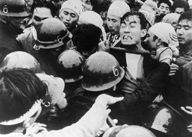Record of Blood: Sunagawa
(“Ryuketsu no kiroku: Sunagawa”) 1956 / B&W / 35mm / 55 min
1956 / B&W / 35mm / 55 min
Photography: Takei Dai, Uematsu Eikichi, Josho Toshio, Teshigahara Hiroshi, Ono Tadashi, Kamei Fumio
Editing: Kamei Fumio, Watanabe Masami, Toyotomi Yasushi, Kishi Tomiko
Sound: Okuyama Junosuke, Ohashi Tetsuya, Ono Matsuo
Music: Nagasawa Katsutoshi
Line Producer: Saito Shigeo
Narrator: Terashima Nobuko
Planning: Sunagawa War Documentary Film
Productions Producer: Ono Tadashi
Production Company, Source: Japan Document Film
This is the third film in the Sunagawa series following The People of Sunagawa (1955) and Wheat Will Never Die (1955). Making use of the second film in the series, it explains the progress made during last year’s struggle and then documents the state of this year’s efforts. On October 12, 1956, 53 surveyors and 1,300 armed police rushed the gathered union and Zen Gaku Ren (the All Japan Federation of Self-Governing Students Associations) members who then formed a scrum to protect themselves. 278 people from both sides were injured. On the 13th, at the protest’s peak, 5,000 workers and Zen Gaku Ren members had been mobilized when the police attacked the demonstrators’ picket lines. 844 protesters and 80 police were injured. Public opinion erupted against the the violence of the armed police and the government’s lack of a policy, and on the 14th, the radio suddenly announced that the government would stop its survey. Sunagawa overflowed with joy and excitement, and a victory demo was held. On the 15th, a National People’s Rally was held to celebrate the victory of Sunagawa’s fight against the base, and protesters who had sustained grave injuries came from the hospital to address the meeting. The film crew stayed with Sunagawa farmer Aoki Namikichi from October 4, living communally with union members and students as they filmed. The Sunagawa War Documentary Film Productions, created as a joint effort between six groups, including the General Council of Trade Unions of Japan (Sohyo), lent their strong support to the film’s planning, filming and national release. This film was blown up to 35mm, and screened at theaters around the country including the Bungei-za in Ikebukuro (Tokyo).
